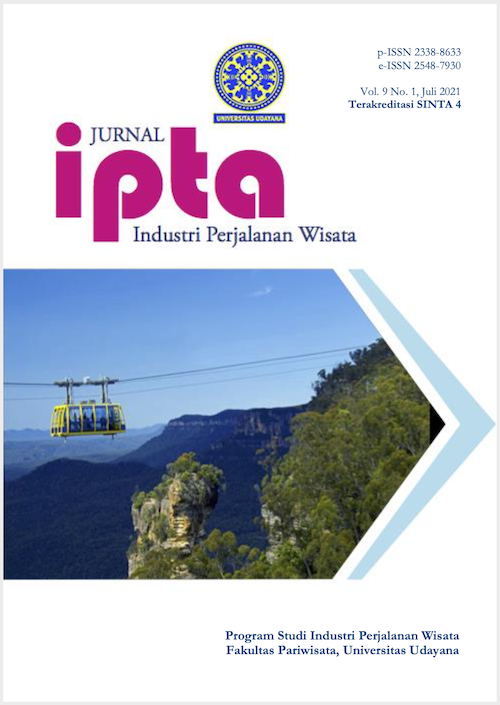MODEL PENGENDALIAN SOSIAL PREVENTIF DALAM MENANGANI PENYIMPANGAN PERILAKU WISATAWAN MANCANEGARA DI KABUPATEN BADUNG
Abstract
Deviations in the behavior of foreign tourists often occur in Badung Regency. Forms of deviant behavior include aggressive behavior, behavior against authority, disrespectful behavior and stupid behavior. The need for a preventive social control effort in anticipating the occurrence of deviations in the behavior of foreign tourists in the future. Determination of informants using purposive sampling and snowball sampling. Data collection is done by observation, interviews, literature study, and documentation. Data analysis techniques using qualitative analysis with the creditability test and the dependability test. The discussion resulted in a model of the construction display framework of preventive social control in Badung Regency, which was formed based on facts or the phenomenon of behavior deviations that often occur. In the introduction of the forms of deviant behavior of foreign tourists there are 4 forms and have a total of 17 behaviors and the total forms of such deviations require social control with a preventive approach. In the preventive approach there are 10 ways that can control foreign tourists to deviate. The role of tourism stakeholders (local communities, government and tourism entrepreneurs) is needed to distribute Do's and Don't's in Bali brochures. The brochure will later contain supporting pictures or illustrations to attract the reader's interest, understand the meaning in each sentence. Preventive social control material by dividing 3 material is presented, namely: Do's in Bali, Do's in Bali, and Why in Bali. After the mechanism for distributing brochures is carried out by stakeholders and there is still a deviation of tourist behavior, the next stage of violators will be subject to sanctions.
Downloads
References
Bali Puspa, News. 2020. Ngotot Jogging Wisatawan Asal Amerika Dirantai Pecalang. https://www.balipuspanews.com/ngotot-joggingwisatawan-asal-amerika- dirantai-pecalang.html. Diakses pada 30 Maret 2020.
Bidell & Deacon. 2010. School Counselors Connecting the Dots Between Disruptive Classroom Behavior and Youth Self-Concept.
Bovee, Courtland L., et al. 1995. Marketing. 2 nd ed. McGraw – Hill, Inc., New York.
News, Tribun Medan. 2020. Bule Slovakia Sebut Budaya Indonesia Diskriminatif, Kesal Lantaran Tak Boleh Masuk Pura saat Haid. https://medan.tribunnews.com/2020/03/13/bule-slovakia-sebut- budaya-indonesia-diskriminatif-kesal-lantaran-tak-boleh-masuk-pura- saat-haid?page=2. Diakses pada 06 Mei 2020
Patton, M. (1990). Qualitative evaluation and research methods. California: Sage Publications.
Pendidikan, Dosen. 2014. Contoh Brosur. http: //www.dosenpendidikan.co.id/contoh-brosur/. Diakses pada 14 juni 2020
Pia Todras. 2007. Teachers Perspective of Disruptive Behavior in the Classroom. Dessertation. Faculty of the Chicago School of Professional Psychology.
Pitana, I. G. dan Gayatri, P. G. 2005. Sosiologi Pariwisata. Yogyakarta : Andi Offset.
Pitana, I Gde dan I Ketut Surya Diarta. 2009. Pengantar Ilmu Pariwisata. Jakarta: Andi.

This work is licensed under a Creative Commons Attribution-ShareAlike 4.0 International License.





